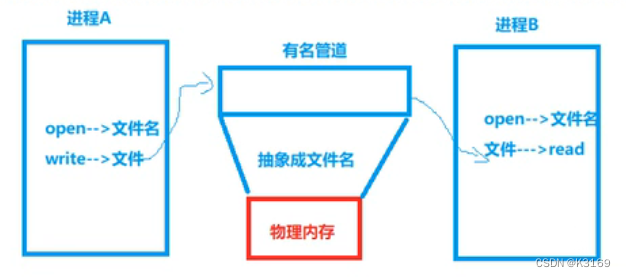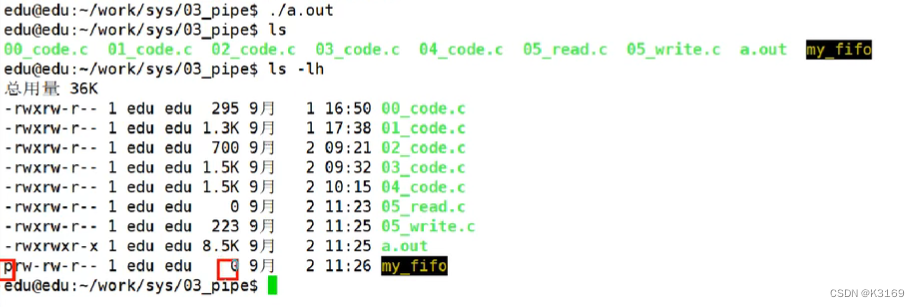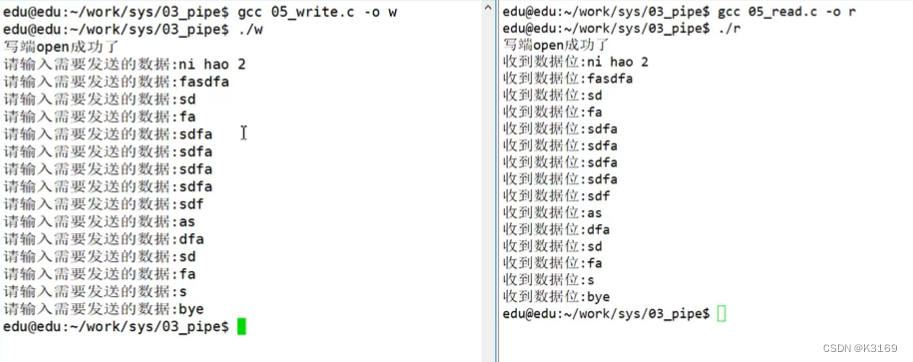文章目录
有名管道(命名管道)
主要用于没有血缘关系的进程间通信。

1 有名管道的特点
命名管道(FIFO)和管道(pipe)基本相同,但也有一些显著的不同,其特点是:
- 半双工,数据在同一时刻只能在一个方向上流动。
- 写入FIFO中的数据遵循先入先出的规则。
- FIFO所传送的数据是无格式的,这要求FIFO的读出方与写入方必须事先约定好数据的格式,如多少字节算一个消息等。
- FIFO在文件系统中作为一个特殊的文件而存在,但FIFO中的内容却存放在内存中。
- 管道在内存中对应一个缓冲区。不同的系统其大小不一定相同。
- 从FIFO读数据是一次性操作数据一旦被读,它就从FIFO中被抛弃,释放空间以便写更多的数据。
- 当使用FIFO的进程退出后,FIFO文件将继续保存在文件系统中以便以后使用。
- FIFO有名字,不相关的进程可以通过打开命名管道进程通信(重要)。
2 有名管道的创建
FIFO文件的创建
#include <sys/types.h>
#include <sys/stat.h>
int mkfifo(const char *pathname, mode_t mode);
参数:
pathname:FIFO的路劲名 + 文件名
mode:mode_t类型的权限描述符
返回值:
成功:0
失败:如果文件已经存在,则会出错且返回-1
例
#include <stdio.h>
#include <sys/types.h>
#include <sys/stat.h>
int main(int argc, char const *argv[])
{
//创建有名管道(两个进程要通信,必须保证两个进程访问的有名管道是同一路劲、名)
mkfifo("my_fifo", 0666);
return 0;
}

3 有名管道的使用案例
3.1 两个程序,一个写FIFO,一个读FIFO
3.1 写FIFO
#include <stdio.h>
#include <sys/types.h>
#include <sys/stat.h>
#include <fcntl.h>
#include <string.h>
#include <unistd.h>
int main(int argc, char const *argv[])
{
//创建有名管道(两个进程要通信,必须保证两个进程访问的有名管道是同一路劲、名)
mkfifo("my_fifo", 0666);
//open以写的方式打开有名管道(阻塞到有进程以读的方式打开)
int fd = open("my_fifo", O_WRONLY);
if(fd < 0)
{
perror("open");
return 0;
}
printf("写端open成功了\n");
//循环写入数据
while(1)
{
//获取键盘输入
char buf[128] = "";
printf("请输入需要发送的数据:");
fgets(buf, sizeof(buf), stdin);
buf(strlen(buf)-1] = 0;
//发送数据
write(fd, buf, strlen(buf));
//退出循环
if(strcmp(buf, "bye") == 0)
{
break;
}
}
close(fd);
return 0;
}
注:open 打开有名管代是带阻塞的,直到有进程以读的方式打开此有名管道
3.2 读FIFO
#include <stdio.h>
#include <sys/types.h>
#include <sys/stat.h>
#include <fcntl.h>
#include <string.h>
#include <unistd.h>
int main(int argc, char const *argv[])
{
//创建有名管道(两个进程要通信,必须保证两个进程访问的有名管道是同一路劲、名)
mkfifo("my_fifo", 0666);
//open以写的方式打开有名管道(阻塞到有进程以写的方式打开)
int fd = open("my_fifo", O_RDONLY);
if(fd < 0)
{
perror("open");
return 0;
}
printf("读端open成功了\n");
//循环的读取数据
while(1)
{
//接受数据
char buf[128] = "";
read(fd, buf, sizeof(buf));
printf("收到数据为:%s\n",buf);
//退出循环
if(strcmp(buf, "bye") == 0)
{
break;
}
}
close(fd);
return 0;
}
注:open 打开有名管代是带阻塞的,直到有进程以写的方式打开此有名管道

3.2 将收、发FIFO合并成一个代码
编译时加入宏名
-D 宏名
如:gcc 01_code.c -o test -D WRITE
#include <stdio.h>
#include <sys/types.h>
#include <sys/stat.h>
#include <fcntl.h>
#include <string.h>
#include <unistd.h>
int main(int argc, char const *argv[])
{
//创建有名管道(两个进程要通信,必须保证两个进程访问的有名管道是同一路劲、名)
mkfifo("my_fifo", 0666);
#ifdef WRITE
int fd = open("my_fifo", O_WRONLY);
#endif
#ifdef READ
int fd = open("my_fifo", O_RDONLY);
#endif
if(fd < 0)
{
perror("open");
return 0;
}
printf("open成功了\n");
#ifdef WRITE
while(1)
{
//获取键盘输入
char buf[128] = "";
printf("请输入需要发送的数据:");
fgets(buf, sizeof(buf), stdin);
buf(strlen(buf)-1] = 0;
//发送数据
write(fd, buf, strlen(buf));
//退出循环
if(strcmp(buf, "bye") == 0)
{
break;
}
}
#endif
#ifdef READ
while(1)
{
//接受数据
char buf[128] = "";
read(fd, buf, sizeof(buf));
printf("收到数据为:%s\n",buf);
//退出循环
if(strcmp(buf, "bye") == 0)
{
break;
}
}
#endif
return 0;
}

4 有名管道读写的特点
操作FIFO文件时的特点,系统调用的I/O函数都可以作用于FIFO,如open、close、read、write等。
4.1 打开FIFO时,非阻寨标志(O_NONBLOCK)产生下列影响
4.1.1 以阻塞方式打开管道
不指定O_NONBLOCK(即open没有位或O_NONBLOCK)
- open 以只读方式打开FIFO时,要阻塞到某个进程为写而打开此FIFO
- open 以只写方式打开FIFO时,要阻塞到某个进程为读而打开此FIFO
- open 以只读、只写方式打开FIFO时会阻塞,调用read函数从FIFO里读数据时read也会阻塞
- 通信过程中若写进程先退出了,则调用read函数从FIFO里读数据时不阻塞;若写进程又重新运行,则调用read 函数从FIFO里读数据时又恢复阻塞
- 通信过程中,读进程退出后,写进程向有名管道内写数据时,写进程也会(收到SIGPIPE信号)退出
- 调用write函数向FIFO里写数据,当缓冲区已满时write也会阻塞
4.1.2 以非阻塞方式打开管道
指定O_NONBLOCK(即open没有位或O_NONBLOCK)
- 先以只读方式打开:如果没有进程已经为写而打开一个FIFO,只读open成功,并且open不阻塞
- 先以只写方式打开:如果没有进程已经为读而打开一个FIFO,只写open将出错返回-1
- read、write读写有名管道中读数据时不阻塞
- 通信过程中,读进程退出后,写进程向有名管道内写数据时,写进程也会(收到SIGPIPE信号)退出。
注:open函数以可读可写方式打开FIFO文件时的特点:
- open不阻塞
- 调用read函数从FIFO里读数据时read会阻塞
- 调用write函数向FIFO里写数据,当缓冲区已满时write也会阻塞
5 单机QQ聊天程序
实现单机QQ聊天:父进程创建子进程,实现多任务。父进程负责发信息(向FIFO里写数据),子进程负责接受信息(从FIFO里读数据)。打开有名管道的用阻塞的方法。
5.1 两个程序实现单机聊天
5.1.1 用户 bob
#include <stdio.h>
#include <sys/types.h>
#include <sys/stat.h>
#include <fcntl.h>
#include <string.h>
#include <unistd.h>
int main(int argc, char const *argv[])
{
//创建两个有名管道
mkfifo("bob_to_lucy", 0666);
mkfifo("lucy_to_bob", 0666);
int i = 0;
for(; i < 2; i++)
{
pid_t pid = fork();
if(pid == 0)
break;
}
if(i == 0) //子进程1 负责发消息 (bod 发给lucy)
{
int fd = open("bob_to_lucy", O_WRONLY);
if(fd < 0)
{
perror("open");
_exit(-1)
}
//获取键盘输入
while(1)
{
//获取键盘输入
char buf[128] = "";
printf("\rbob:");
fgets(buf, sizeof(buf), stdin);
buf(strlen(buf)-1] = 0;
//发送数据
write(fd, buf, strlen(buf));
//退出循环
if(strcmp(buf, "bye") == 0)
{
break;
}
}
close(fd);
//退出进程
_exit(-1);
}
else if(i == 1) //子进程2 负责收消息 (lucy 发给 bob)
{
int fd = open("lucy_to_bob", O_RDONLY);
if(fd < 0)
{
perror("open");
_exit(-1)
}
//循环的读取数据
while(1)
{
//接受数据
char buf[128] = "";
read(fd, buf, sizeof(buf));
printf("\rlucy:%s\n\rbob:",buf);
//退出循环
if(strcmp(buf, "bye") == 0)
{
break;
}
}
close(fd);
return 0;
}
else if(i == 2) //父进程负责回收资源
{
while(1)
{
pid_t pid = waitpid(-1, NULL, WNOHANG);
if(pid > 0)
{
printf("子进程%d退出了\n",pid);
}
else if(pid == 0)
{
continue;
}
else if(pid < 0)
{
break;
}
}
}
return 0;
}
5.1.2 用户 lucy
#include <stdio.h>
#include <sys/types.h>
#include <sys/stat.h>
#include <fcntl.h>
#include <string.h>
#include <unistd.h>
int main(int argc, char const *argv[])
{
//创建两个有名管道
mkfifo("bob_to_lucy", 0666);
mkfifo("lucy_to_bob", 0666);
int i = 0;
for(; i < 2; i++)
{
pid_t pid = fork();
if(pid == 0)
break;
}
if(i == 0) //子进程1 负责发消息 (lucy 发给 bob)
{
int fd = open("lucy_to_bob", O_WRONLY);
if(fd < 0)
{
perror("open");
_exit(-1)
}
//获取键盘输入
while(1)
{
//获取键盘输入
char buf[128] = "";
printf("\rlucy:");
fgets(buf, sizeof(buf), stdin);
buf(strlen(buf)-1] = 0;
//发送数据
write(fd, buf, strlen(buf));
//退出循环
if(strcmp(buf, "bye") == 0)
{
break;
}
}
close(fd);
//退出进程
_exit(-1);
}
else if(i == 1) //子进程2 负责收消息 (bob 发给 lucy)
{
int fd = open("bob_to_lucy", O_RDONLY);
if(fd < 0)
{
perror("open");
_exit(-1)
}
//循环的读取数据
while(1)
{
//接受数据
char buf[128] = "";
read(fd, buf, sizeof(buf));
printf("\rbob:%s\n\rlucy:",buf);
//退出循环
if(strcmp(buf, "bye") == 0)
{
break;
}
}
close(fd);
return 0;
}
else if(i == 2) //父进程负责回收资源
{
while(1)
{
pid_t pid = waitpid(-1, NULL, WNOHANG);
if(pid > 0)
{
printf("子进程%d退出了\n",pid);
}
else if(pid == 0)
{
continue;
}
else if(pid < 0)
{
break;
}
}
}
return 0;
}

5.2 两个程序合并为一个实现单机聊天
同3.2节
























 1570
1570











 被折叠的 条评论
为什么被折叠?
被折叠的 条评论
为什么被折叠?










